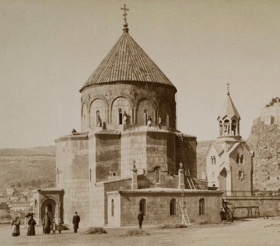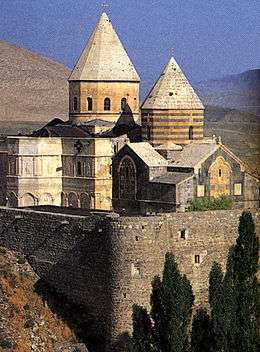Cathedral of Kars
The Cathedral of Kars, also known as the Holy Apostles Church (Armenian: Կարսի Սուրբ Առաքելոց եկեղեցի, Karsi Surb Arakelots' yekeghets'i; Turkish: Aziz Havariler Kilisesi[8] or "Church of the Twelve Apostles" 12 Havariler Kilisesi)[1][3][9] is a former Armenian Apostolic church in Kars, eastern Turkey. Built in the mid-10th century by the Armenian Bagratid King Abas I (r. 928–953), it was converted into a mosque in 1579. In the 19th and early 20th century it was converted into a Russian Orthodox and later Armenian cathedral. In 1993 it was again converted into a mosque and is called Kümbet Mosque[5] (Turkish: Kümbet Camii, literally "domed mosque").[10] It currently comprises part of a larger Islamic complex that includes the Evliya Mosque, the biggest mosque in Kars.[11]
 Kümbet Mosque in 2014 | |
| Coordinates | 40.611336°N 43.091617°E |
|---|---|
| Location | Kars, Turkey |
| Type | Armenian Apostolic cathedral (until 1065) Mosque (1579–1877) Russian Orthodox cathedral (1877–1918) Mosque (1918–19) Armenian Apostolic church (1919–20) Kars Museum (1964–78)[1] Mosque (1993–present)[1][2] |
| Material | Basalt[3][4] |
| Beginning date | 930[5][6] or 931–2[4][7] |
| Completion date | 937,[3][4][6] 943[5][8] or 967[7] |
| Dedicated to | Twelve Apostles |
Overview
The cathedral is located at the base of the Kars Citadel.[7]
Historians Stepanos Asoghik, Samuel of Ani, and Mxitar of Ayrivank called the church a cathedral. In 19th century Armenian sources it began to be known as the Church of Holy Apostles.[7]
Architecture

It is a central planned domed tetraconch,[7] and imitates the seventh-century Church of Saint John, Mastara.[6][12] The main entrance of the church is on the western side also has two more gates on the south and north sides.[3] "Its interior plan is reflected in the exterior volumes. Four apses radiate from a central square bay, over which rises a circular dome. Externally, the right angles of the square between the conchs protrude about three meters beyond the sides of the apses; inside they are represented by four dihedral angles each surmounted with a squinch."[7]
"On the spandrels between the twelve arches on the drum there are twelve figural reliefs in standing position. These are executed in a very primitive style. According to J.M. Thierry, these figures represent the twelve apostles, whose cult was brought from Byzantium in the 10th-11th centuries."[7]
History
Early history
The church has no surviving building inscriptions and the exact dates of its foundation are unknown. Inscriptions were possibly removed in the later centuries by Muslims. However, an 11th-century source states that the cathedral was built during the reign of King Abas, who ruled Bagratid Armenia between 928 and 958. Kars served as the Bagratid capital during this period. The 11th-century historian Stepanos Asoghik wrote that king Abas "built the holy cathedral of the city of Kars with blocks of stone, with sandstone blocks that were polished with steel: [the church] was surmounted by a circular dome whose ornamentation resembled the vault of heaven",[7] and that the cathedral was already completed at the time of Catholicos Ananias I (Anania of Mokk)'s tenure [943-967]. Chronicles Samuel of Ani (12th century) Mxit'ar of Ayrivank (13th century) give 931-932 as the beginning of the construction of the church.[7]

Abandonment and conversion into a mosque
The church was probably abandoned after the Seljuks conquered Kars in 1064/5.[1] It is believed that the church was "partially covered with earth" during the Middle Ages.[7]
Following the conquest of large parts of Armenia, including Kars, by the Ottman Empire in the 16th century the church was converted into a mosque in 1579[1] by Mustafa Pasha. The Suleyman Efendi mosque mentioned by the 17th century Turkish traveler Evliya Çelebi is assumed to be the Kars cathedral.[7]
19th & early 20th century
After the Russian capture of Kars in 1877 it was converted to a Russian Orthodox church.[1][7] "Porticos were built in front of the west, north and south portals, whose original structure was destroyed. A sacristy was erected on the east side which covered the entire façade, and inside an iconostasis was built."[7]
During the later stages of World War I's Caucasus Campaign, following the October Revolution and the civil war, the Russian troops abandoned the Caucasus en masse. In April 1918 the Turks captured Kars and the church was again converted into a mosque. According to the Armistice of Mudros, the Turks were required to withdraw to the pre-war frontier. The Republic of Armenia gained control of the city in 1919 and the church was converted back to an Armenian church.[7]
Since 1920

In 1920 Kars again fell to Turkey during the Turkish–Armenian War. The cathedral ceased to function as a church and briefly operated as a mosque "but soon thereafter the Kemalist government put it up for sale. The municipality of Kars bought it and planned to demolish it to build a school on its site, but the plan was never carried out. In the 1950s the municipality used it for a depot for petroleum."[7]
It functioned as Kars Museum between 1964 and 1978. After the museum moved to a new site, the monument lay derelict until 1993 when it was converted to a mosque under the name Kümbet Mosque and handed over to the Presidency of Religious Affairs.[1][2] The Economist cited its reopening as a mosque as an example of eradication of the Armenian cultural heritage in Turkey.[13] According to S. Peter Cowe, as of 1998, "the original high Armenian bema with the tall 19th century Russian iconostasis [were] still in place."[14]
In a 2005 interview Kars Mayor Naif Alibeyoğlu (tur) stated about plans to restore the cathedral and added that after renovation a "cultural center or museum would be much more appropriate."[1]
References
- Saymaz, İsmail (16 August 2005). "Bin yıldır paylaşılamıyor [It has not been shared for a thousand years]". Radikal (in Turkish). Archived from the original on 6 December 2014.
- "Camiye çevrilen kilisede ayine izin yok". Milliyet (in Turkish). 23 June 2008.
- "Kümbet Camii (12 Havariler Kilisesi)". kars.gov.tr (in Turkish). Archived from the original on 6 November 2014.
- "Kars'ın tarihi ve turistik yerleri". Zaman (in Turkish). 1 July 2007. Archived from the original on 6 December 2014.
- Watenpaugh, Heghnar Zeitlian (December 2014). "Preserving the Medieval City of Ani: Cultural Heritage between Contest and Reconciliation". Journal of the Society of Architectural Historians. 73 (4): 538. doi:10.1525/jsah.2014.73.4.528. JSTOR 10.1525/jsah.2014.73.4.528.
- Jones, Lynn (2007). Between Islam and Byzantium: Aght'amar and the Visual Construction of Medieval Armenian Rulership. Burlington, Vermont: Ashgate. p. 98. ISBN 978-0754638520.
Between 930 and 937 Ashot II's uncle and successor, Abas I, built a cathedral at Kars, then the Bagratid capital, in imitation of the seventh-century church of St John at Mastara.
- "Kars". Armenian Studies Program California State University, Fresno. Archived from the original on 30 October 2014.
- Sağır, Güner (23–28 May 2011). "Kars İli̇ ve Çevresi̇nde Yer Alan Ortaçağ Ermeni̇ [Medieval Armenian sites in and around Kars]" (PDF) (in Turkish). Malatya: Turkish Ministry of Culture and Tourism. General Directorate of Cultural Assets and Museums. pp. 12–14.
- Demirci, Mehmet; Kurt, Süleyman; Öylek, Yahya; Kaban, Murat (29 March 2007). "Ermeni açılımlarına Akdamar da ekleniyor". Zaman (in Turkish). Archived from the original on 8 December 2014. Retrieved 6 December 2014.
Ermenistan resmi heyeti, Van'dan önce geldikleri Kars'ta eski ismi "12 Havariler Kilisesi" olan Kümbet Camii...
- "Կարսի Առաքելոց եկեղեցին պատմության ընթացքում չորս անգամ վերածվել է մզկիթի. թուրք պաշտոնյա" (in Armenian). Armenpress. 19 January 2013.
Թուրքերն այժմ այն կոչում են «Գմբեթավոր մզկիթ»:
- Sarıaslan, Kübra Zeynep (September 2010). "Pamuk's Kars and Its Others: An Ethnography on Identifications and Boundaries of Ethnicity, Nationalism and Secularism" (PDF). Middle East Technical University. p. 53. Archived from the original (PDF) on November 4, 2014.
Evliya Mosque is the biggest mosque in Kars, with the largest community. The mosque was newly constructed and it is located at the center of a huge religious complex that includes the Armenian Church, which was converted to a mosque in 2007.
- Khalpakhchian, Hovhannes (1979). "Կարսի Առաքելոց եկեղեցի". Soviet Armenian Encyclopedia vol. 5 (in Armenian). Yerevan: Armenian Encyclopedia. p. 344.
Մաստարայի եկեղեցու տիպի կենտրոնագմբեթ կառույց է՝ չորս աբսիդով, արլ-ից երկու ավանդատներով:
- "Turkey and Armenia: Two vast and ugly blocks of stone". The Economist. 13 January 2011.
He might have included Kars' Armenian legacy, but that is being erased. A long-abandoned tenth-century Armenian church recently reopened—as a mosque.
- Cowe, Peter (1998). "Mental Snapshots from My 1998 Journey". bvahan.com. Los Angeles. Archived from the original on 2017-03-02.CS1 maint: BOT: original-url status unknown (link)
External links
| Wikimedia Commons has media related to Holy Apostles Church of Kars. |


